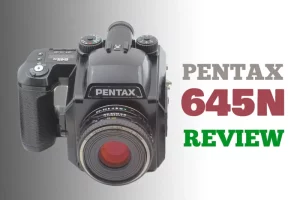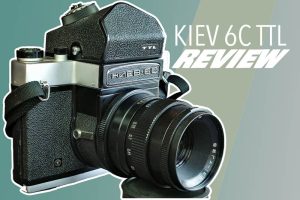Hasselblad 500C/M Review: The camera that portrayed the earth
Last Updated on December 28, 2023
Editorial Note: By purchasing through the links on DustyGrain, we may earn a commission. These earnings do not dictate our opinions or product evaluations.
In this review of the Hasselblad 500c/m we will talk about the mark that this camera has left on history, not only photography but culture in general, its technological contributions and the relevance it has in today’s market .
The first photo of the earth captured by a camera was made with nothing less than this camera, iconic photos of the history of the 20th century that we usually see ad nauseam have most likely been captured by this camera.
In our list of the best medium format film cameras we had already mentioned some of its characteristics and general functions (read here). In this review we have to go deeper to analyze its functions in more detail.
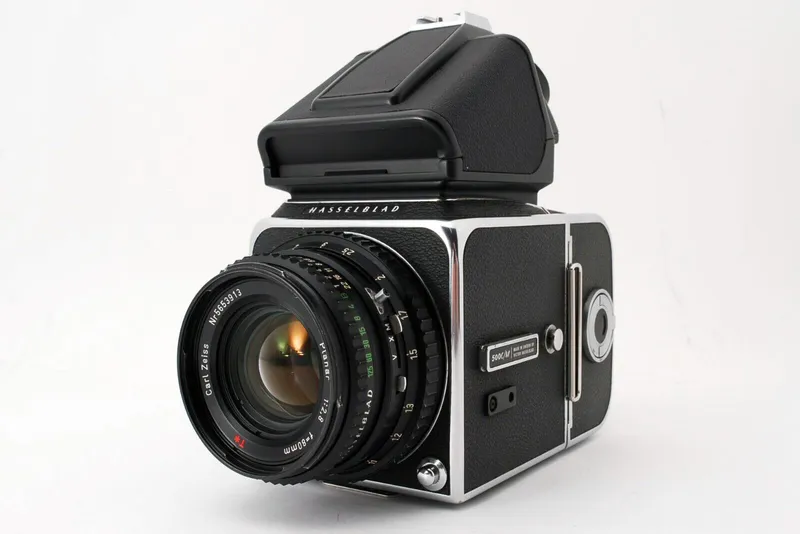
Table of Contents
Hasselblad 500CM Specs
| Year release: | 1953 (c) / 1970 (cm) |
| System: | SLR, Single Lens Reflex |
| Film type: | 120, 220 film |
| Film/frame size: | 6×6 cm (mainly) |
| Shutter type: | In Lens, leaf shutter (Synchro-Compur) |
| Shutter speed: | 1sec to 1/500sec |
| Metering: | EV 4 – 19, with Prism Finder |
| Flash sync: | All speeds |
| Battery: | None |
| Major lens: | 80mm f/2.8 Carl Zeiss Planar T* |
| Weight: | Body only: 600g, With 80mm: 1.5kg |
| Body dimensions: | 170mm x 109mm x 104mm (Box) |
History
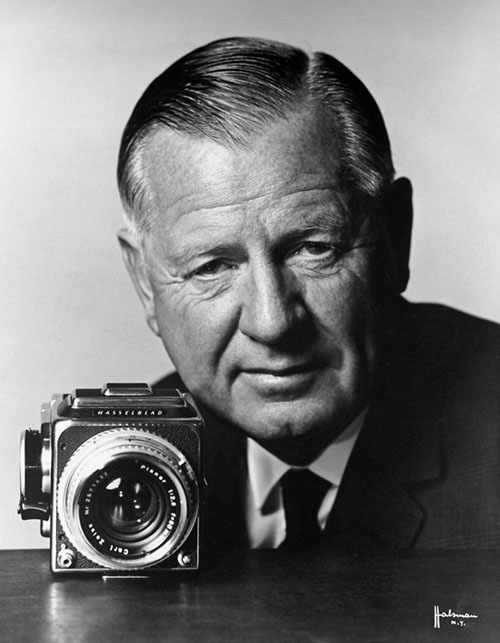
Victor Hasselblad, a Swedish photographer and inventor, started his career back in the ’30s by building cameras for the Swedish Royal Air Force. After years of making military cameras, Victor Hasselblad had in mind a civilian model. While developing its design, his workers built watch machinery and prepared for the launch of the Hasselblad 1600F in 1948. Five years later, after this first model, that wasn’t so successful, Victor Hasselblad presented the 1000F that improved both its design and features as well as offering six different options.
Hasselblad introduced the V series in 1957, incorporating a central shutter. The first camera of the V series, the 500C, was so named because it used a Compur shutter. Central shutters have a limit on maximum speed of 1/500 but they can sync flash at any speed, which made the 500c ideal for use in studio photography.
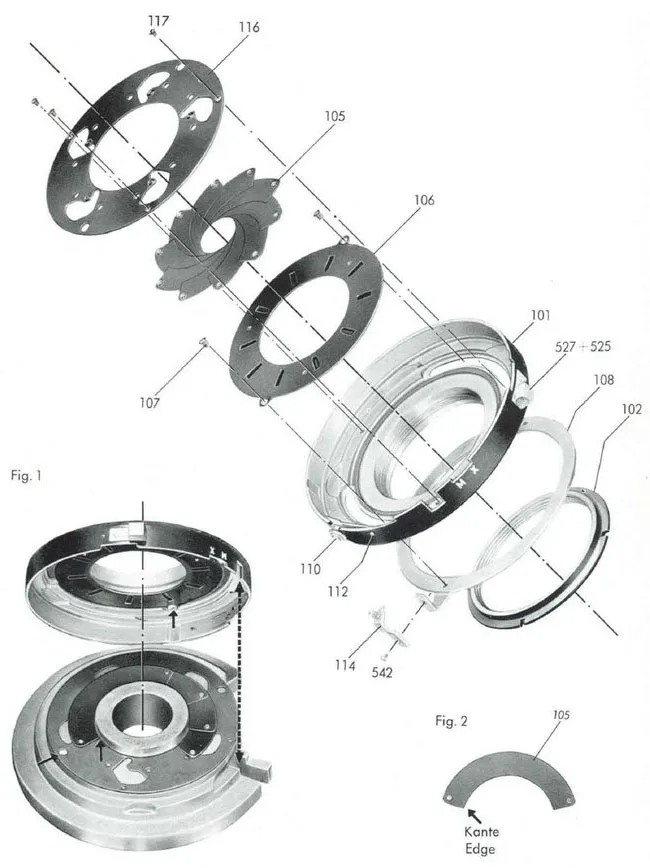
In 1970, the Hasselblad 500C/M was released. The M stands for modified, but it could also stand for modular, because with this model, the concept of a camera that could be customized according to your needs became available.
Apolo 11 Hasselblad
The 500cm became relevant in history when the crew of Apollo 11 brought back the entire expedition to the moon, obviously with a modified version and specially conditioned for space conditions, this Hasselblad model is known as the NASA Hasselblad 500EL or Lunar Hasselblad.

To this day it is surprising to see a photo of the earth taken from space, you can imagine taking it yourself with your Hasselblad, I don’t know about you but I could spend long minutes looking at this fascinating photo. The first portrait of the earth taken from space.

The body
One of the peculiarities of the body of a Hasselblad 500c is that it is completely removable, basically the lens, the viewfinder, the back and even the rewind crank are attached to the body. Which makes it a fairly versatile camera for professionals.
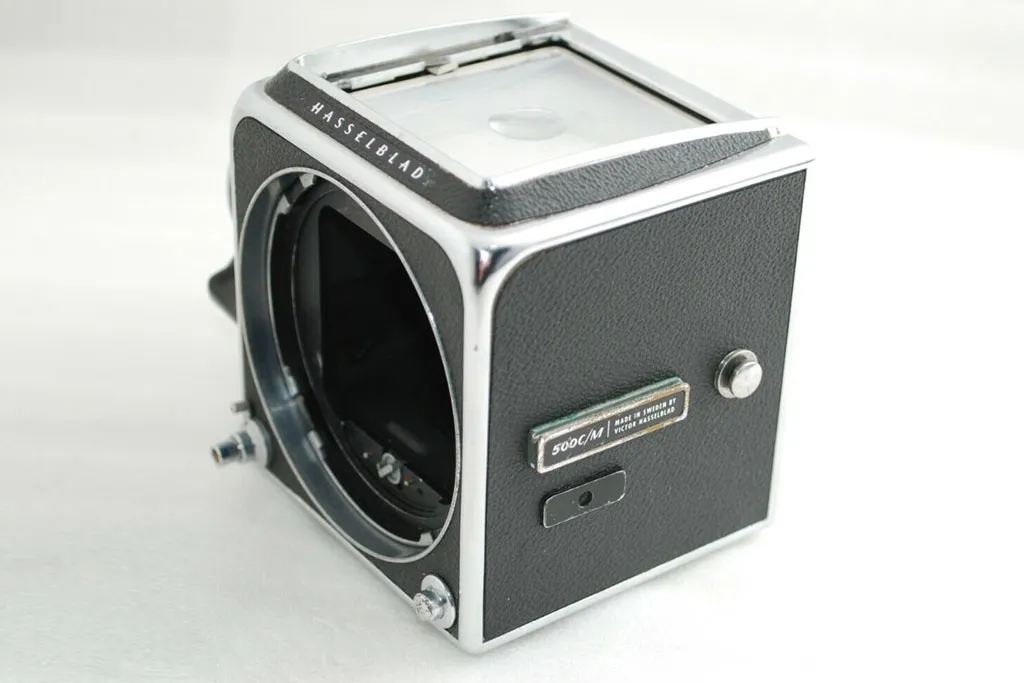
Being a camera that can be disassembled, there are many combinations to play with when choosing components that adapt to the type of photography we want to do. That’s why the 500c is not only suitable for landscapes and portraits, with a good combination of its components you can even use it for street photography or fashion photography.
It is so versatile that you can even adapt a digital sensor back and turn it into a modern camera with features that few cameras can achieve.
That’s why in the arsenal of the most renowned professional photographers you will always see that the Hasselblad 500c occupies an important place. From a VOGUE photographer to a National Geographic photographer.
Body functions
The body (the case) itself, being very versatile, performs very few functions on its own, most of the functions are really separated in the different components, including the main shutter that is located in the lens. The body performs a secondary shutter (the rear one) that works in sync with the main one.
The mirror
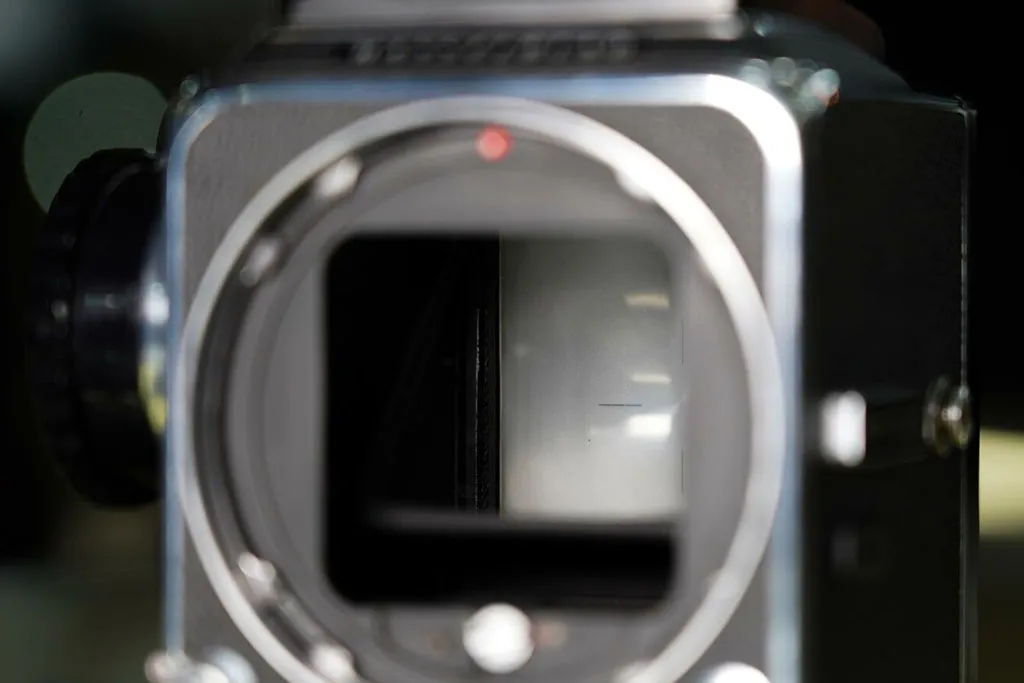
The system’s mirror is located in the body, which is functional when focusing with the lens and is operable with or without an adaptable viewfinder (prism), although it does have one.
The viewfinder is completely square, occupies the full diameter of the body (6cm per side) and is quite bright. It takes time to get used to seeing the image horizontally inverted, but it’s definitely enjoyable.
By default, Hasselblads have the common chimney finder, but there are also prisms that correct the inversion from left to right and they are the ones we will see next.
Prisms
After the launch of the 500C/M in 1970, many improvements in parts and accessories were introduced, including prisms/finders, that some included meters and others didn’t, let’s see some of both.
PME Prism finders, Metered 45º
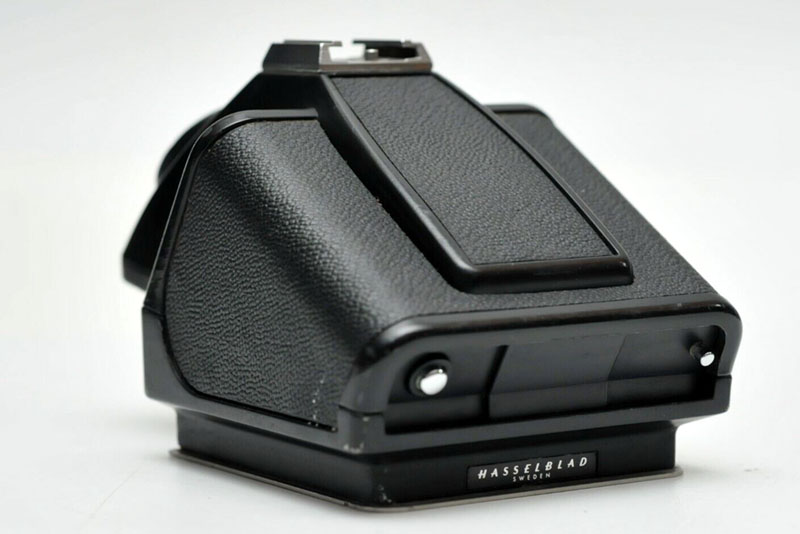
This is a 45º viewfinder that allows framing by correcting the inversion from left to right that common “chimney” viewfinders have. It also allows the measurement of light by means of an electronic photometer inside. Requires a 6v 4LR44 or 4SR44 battery.
It is very bright and impresses the first time you go through it, but along with that it should also be noted that this viewfinder adds considerable weight to the camera. The PME models can be the PME, PME3 and PME5. They are arranged chronologically.
PM Prism finders, Non-metered 45º

The PM range are 45º prisms very similar to the previous ones, with the only difference being that they don’t have a meter. For many professionals they are the most convenient since they are slightly lighter and they prefer to do without the meter since over the years they can lose accuracy (supposedly). PM models can be PM, PM3 and PM5.
PM90’s Prisms
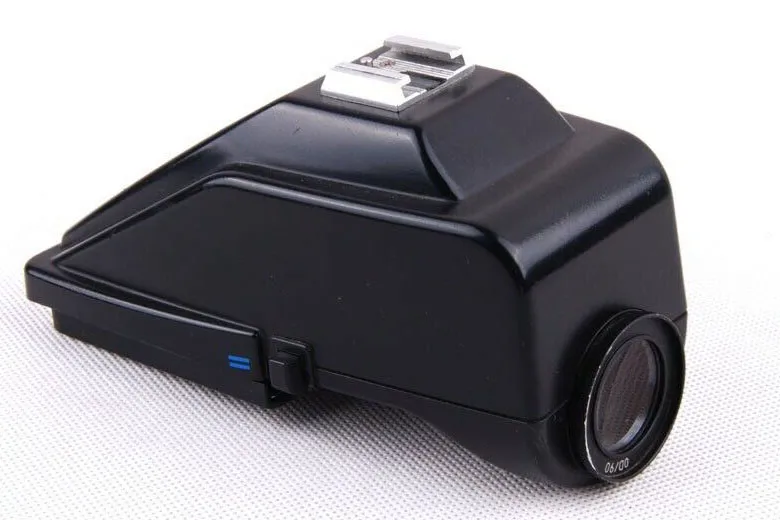
These versions of prisms are positioned at 90º to the mirror, which provides a straight line view to the eye. Like the previous ones, they are also divided between those that have a meter and those that do not. The metered version is the PME90, and the non-metered version is the PM90.
Alternative Metering Options
There are many ways to take the measurement if you do not have any of the aforementioned prisms. Some are simple and cheap alternatives like using an app, which is not really recommended. The proper thing would be to use a handheld light meter, especially if you are in a controlled environment. You can even choose to adapt a hot shoe light meter to use on it. Some options:
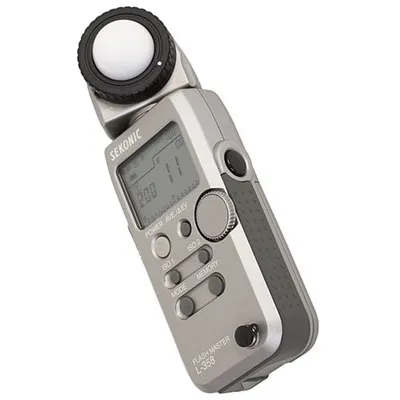

The rewind
The rewind of the film works by means of the crank (removable) that is on the right side of the camera (holding it). Its operation is one of the important ones of the body, since its mechanism is one of the most sophisticated that it possesses.
It serves to carry out the dragging of the film which is contained within the back. Next to the handle is the rewind load indicator (red/white dot), which indicates if the shutter is in the firing position or if the film needs to be advanced/loaded.
Lenses
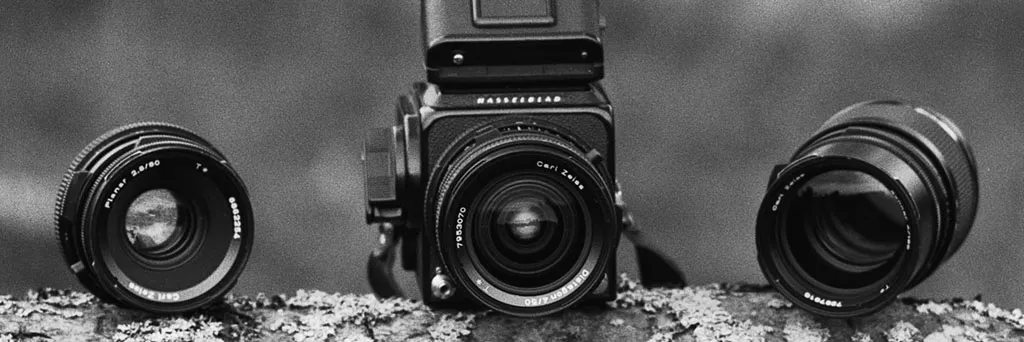
There are several generations of lenses for the Hasselblad 500CM and for the V system, which were released at different times in their history, the best known are three and bear the following designations.
- C lenses: The first generation of lenses released between the years 1959-1974, C of Compur technology.
- CT lenses: The second generation of lenses, appeared between the years 1974-1979, basically the same Compur shutter lenses but with multicoating.
- CF lenses: Third generation of lenses, which were released between 1980-1989, this generation of lenses comes with focal plane shutter support.
What are the most recommended lenses to start with the Hasselblad 500c?
There are a couple of lenses that are appropriate to start with the 500CM, they are generally the ones that also have more units on the market since if they don’t come with the camera when you buy it, they are just as easy to find since they are usually the most sought after, especially if you just got a Hasselblad.
Carl Zeiss Planar 80mm f/2.8 CF T*
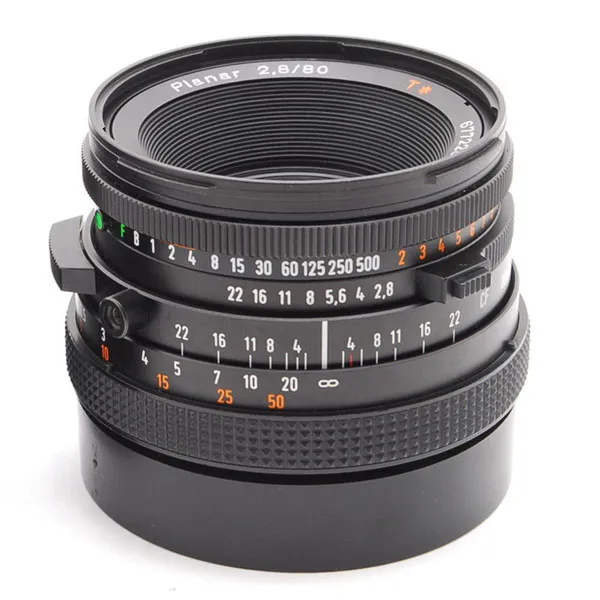
The 80mm planar is probably the most popular lens for the 500CM, it belongs to the most modern generations of Hasselblad V-system lenses. It has a minimum focus distance of 3 feet (1 meter approx). By default it comes in color although there are less common versions in chrome. This is simply the king of the 80mm and is the best value for money.
Carl Zeiss Distagon 50mm f/4 CFi T*
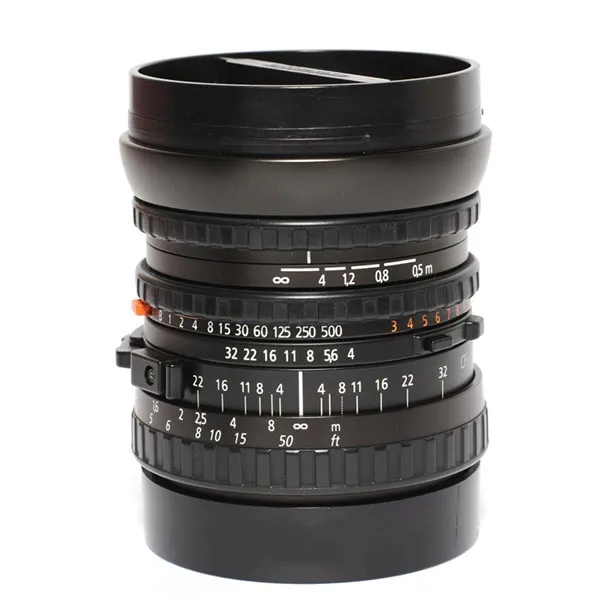
The Distagon 50mm f/4 is the wide angle option of this recommendation, we are facing a spectacular lens, it is the perfect companion to the 80mm since being wide angle it’s perfect for landscapes, architecture or small spaces. It has corrected distortion and chromatic aberration, and its construction of the highest quality. It has FLE (floating lens element) technology that helps correct distortions when shooting at short distances. The minimum focus distance is 0.5m and it weighs approximately 800g, it is a little beast of a lens made with the best of Carl Zeiss.
Price and Where to Buy
The body of a Hasselblad 500CM is priced between $500-850 USD, depending on the condition. Of course, one must take into account the budget for the other camera components. You can purchase it online or in physical second-hand stores; fortunately, it’s not a camera that is scarce in the market, although keep in mind that it may have a slightly higher cost in a physical store.
Check prices on KEH Camera Store
500CM Sample shots
These are some beautiful shots taken with the Hasselblad 500C/M by Christopher Crouzet.





Conclusion
In this review of the Hasselblad 500CM we have seen how it’s definitely one of the most important, versatile and sophisticated cameras in history. Today, after half a century, it remains in force and is the professional standard in the industry. Being the camera that we all would like to have one day in our collection.
If you are interested in acquiring one, we recommend that you watch this video where Jonathan Harris tells you all the details to take into account if you want to get one on the second-hand market.
Camera Manual
You can consult the manual on the butkus website and download the pdf instructions for the Hasselblad 500C, which is also used for CM. Here the link.

Written by Jorge Ferrufino
“I am a fashion photographer and an analog photography enthusiast since the beginning of my career (15 years ago). I have had the opportunity and honor of showcasing my work in various galleries and publications around the world.“



